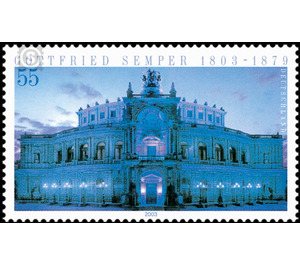200th birthday of Gottfried Semper - Germany / Federal Republic of Germany 2003 - 55 Euro Cent
Theme: Art & Culture
| Country | Germany / Federal Republic of Germany |
| Issue Date | 2003 |
| Face Value | 55.00 |
| Stamp Type | Postage stamp |
| Item Type | Stamp |
| Chronological Issue Number | 2244 |
| Chronological Chapter | GER-BRD |
| SID | 631553 |
| In 36 Wishlists | |
Gottfried Semper was born on November 29, 1803 in Altona near Hamburg, the son of a wealthy wool manufacturer. After graduating from high school in 1823, he first studied mathematics in Göttingen and from 1825 architecture in Munich with Friedrich von Gärtner. From 1826 he worked in Paris. From 1830 to 1833 he undertook a study tour of Italy and Greece, during which he became acquainted with the architecture of antiquity. His study "Provisional Remarks on Painted Architecture and Sculpture among the Elder" from 1834 established his internationally excellent reputation as an analytical thinker. On September 30, 1834, Semper became a professor of architecture at the Art Academy in Dresden. In his view, the function of a building in plan, exterior and decor should be expressed. Semper is considered a leading exponent of "historicism" - an art form characterized by the use of historical styles. In the up-and-coming city of Dresden, Semper earned the reputation of a versatile architect. So he designed in 1837 and 1838, the local women's home and Maternispital. His main interest, however, was major construction projects. The opera house built in 1838 in the style of the Italian High Renaissance and now named after him became world famous in Dresden. Another important building he designed was the synagogue, also built in 1838. Gottfried Semper participated with Richard Wagner in Dresden in the bourgeois May revolution of 1849. After their defeat, he fled to Paris for fear of reprisals and later went to London. In 1855, Semper became professor of architecture at the Polytechnic in Zurich through the mediation of Richard Wagner. There he published from 1860 his major art-theoretical work "The style in the technical and tectonic arts or practical aesthetics". For King Ludwig II of Bavaria, Semper worked out plans for a Richard Wagner Festival Theater in Munich from 1864 to 1866, but this was not realized. In 1871 Semper moved to Vienna. With Carl Freiherr von Hasenauer he delivered, among other things, the designs for the 1874 built and now world famous Vienna Burgtheater. Gottfried Semper died on 15 May 1879 in Rome.


